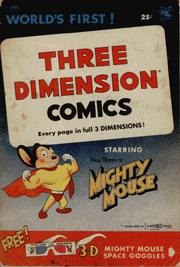

Some of the most unusual comic books ever produced are the three dimension or 3-D comics which enjoyed a brief popularity in 1953 and 1954. It is necessary to view these comic books with the red and green 3-D glasses that were included with the comics. Viewed without these glasses the artwork in 3-D comics appears as off-register red and green images. But seen through the glasses the art gives a monochrome image with depth that is often startlingly realistic.
The 3-D craze is now one of the hallmarks of the fifties. It was initiated in 1952 in motion pictures as part of an attempt by movie producers to lure the public away from their new television sets and back into movie theaters. By the time the first 3-D comic book appeared a year later, magazines and newspapers had begun using the red and green 3-D graphics in features and advertisements.
The added realism of 3-D enhances the pictorial drama in comic books. Artists of stature such as Jack Kirby, Wally Wood, Jack Davis, Bernie Krigstein, Joe Kubert, Howard Nostrand and Bob Powell have all created art for 3-D comic books. In their capable hands the use of 3-D in comic books has given us some of the medium's most visually exciting images.
The principle behind 3-D is fairly simple and is based on the fact that human vision is binocular. Our eyes are separated by a distance of about two and a half inches. Since each eye is in a slightly different position, we commonly perceive objects from two different points of view at the same time. The perception of depth is a result of these two slighty different perspectives. 3-D reproduces the mechanics of binocular vision.
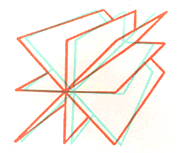
Stereoscopic, or 3-D, drawing was created in 1838 by Sir Charles Wheatstone. After a few refinements, his invention, the stereoscope, was to be a popular device which could be found in many turn-of-the century homes. 3 by 7 inch stereographic cards containing two side-by-side images were inserted into the stereoscopic viewer. When seen through the viewer the two images were combined into a single image with depth.
The first three-dimensional motion pictures were developed by William Friese-Green in 1889. Friese-Green devised a dioptic camera with twin lenses that took two pictures side-by-side on a strip of celluloid that corresponded to left and right eye view points. The remnants of the Friese-Green system survive today in still versions as the View-Masterviewers that are sold world-wide in toy stores.
All of the 3-D comic books made use of a 3-D device known as the anaglyph. The red-green anaglyphic process is based on the patents of Ducos du Hauron who described the system in 1858. The system requires that the left image be dyed red and the right image be dyed green (or vice versa). The two images are then printed superimposed on the page slightly off-register. The red and green lenses allow each eye to view the page separately and give the effect of depth.
Anaglyphic 3-D was used in motion pictures long before its use in graphics and comic books. The earliest feature film in this process used two projectors and was called The Power of Love debuting in Hollywood in 1922. The films using this early process were called plasticons and plastigrams. A plasticon opened at the Rivoli theater in New York in 1922 which made novel use of the anaglyphic process. Two endings to the film were shown simultaneously. If the audience member desired a happy ending he simply viewed the film through the red filter. If a tragic ending was more to his liking he viewed the film through the green filter.
A similar use of the anaglyph is found in 3-D comic books with Joe Kubert's clever stories of evolution and Harvey Publications' 3-D Blinkey one-pagers. William Castle also used this device for his 1960 film Thirteen Ghosts. Plastigrams used a double coated film process requiring only one projector where the red image was applied to the front of the film stock and the green image to the back.
The red-green anaglyphic process was used sporadically in motion picture houses through the twenties and thirties. Pete Smith's 1936 Audioscopiks, a comedy short produced by MGM, was the first 3-D film with sound. It made use of a two-color Technicolor process adapted for red-green anaglyph by J. A. Norling and J. F. Leventhal. The most popular of Smith's 3-D comedy shorts was Three Dimensional Murder in 1941.
It was Arch Oboler's 1952 film Bwana Devil made with the Natural Vision process in color that started the 3-D craze in the fifties. Bwana Devil was an African adventure film that featured lions, spears and tables hurtling out at the audience. The color 3-D films made use of Polaroid separation, similar in principle to the anaglyph, after a process invented by Dr. Edwin Land. The 3-D glasses used for the color films utilized Polaroid lenses instead of the red-green variety. Most of the fifties 3-D films were seen by audiences through Polaroid lenses.
After Bwana Devil many 3-D films were released which, like the comic books that were soon to see print, embraced a wide range of story genres from Western and romance to adventure and science fiction. Warner Brothers' House of Wax, starring Vincent Price, is one of the most successful 3-D horror films. Universal's 1953 release It Came From Outer Space, adapted from a story-by Ray Bradbury, makes novel use of 3-D with meteors and bug-eyed monsters thrusting out at a startled audience. The Creature From the Black Lagoon was Universal's next 3-D release. It makes excellent use of underwater photography well suited to 3-D. In recent years Universal has re-released lt Came From Outer Space and The Creature From the Black Lagoon in anaglyphic prints for a new generation of (stereo) viewers.
Science fiction is uniquely suited to 3-D. Exploding planets and spaceships are especially dramatic rendered with depth. The first 3-D comic book, Three Dimension Comics No. I starring Mighty Mouse, uses these elements. St. John Publications issued the first Three Dimension Comics in an oversize format. The lead story entitled Men of Sola displays Mighty Mouse thwarting an invasion of the Earth by evil, alien cats. Cities in space, colliding meteors and hurtling spaceships spring from the page out at the viewer. Even the ads are printed in 3-D and they are quite dramatic, particularly an ad for Lionel Trains. Three Dimension Comics is the best of the funny animal 3-D comic books.
St. John Publications was the first to publish 3-D comic books, and they produced more titles than any other publisher. The technical quality on all of the St. John 3-D comics is superior. Joe Kubert and Norman Maurer are responsible for the stereo art conversions appearing in these books and the styles range from the caricatural to the realistic. St. John used a process named 3-D Illustereo under a license granted by American Sterographic Corporation that was owned by Kubert and Maurer.
Full page splash panels never looked better than in 3-D. St. John's House of Terror features highly detailed splash panels that provide a perfect atmosphere for the ghostly stories that follow. Joe Kubert made an innovative use of the new medium in 3-D Comics with the character of Tor in the world of 1,000,000 years ago. For issue No. 3 Kubert devised Panelrama with a cinemascopic spread in the center of the book. Russ Heath contributed excellent renditions of prehistoric creatures such as the triceratops and the brontosaurus. Another clever creation of Kubert's was The Story of Evolution. Viewing through the red and green lenses alternately revealed a horse and elephant in their present stage of evolution or their prehistoric ancestors as they might have appeared long ago.
The Hawk was St. John's only western 3-D comic book. The full page opening splash panel of a story called Gunslinger's Greed depicts a blazing gun battle in a room consumed by smoke and fire. Daring Adventures features Joe Kubert art from Son of Sinbad No. I converted to 3-D. The remainder of the St. John 3-D comic books were of the humorous variety. They include issues of The Three Stooges, Abbott and Costello, Little Eva and Whack, a satirical comic along the lines of Mad.
Harvey Publications turned out quite a few 3-D comic books and the technical quality is quite high. Howard Nostrand, Bob Powell and Jack Kirby all have artwork in the Harvey 3-D comics. In Graphic Story Magazine No. 16 Howard Nostrand discusses production methods of the Harvey 3-D comics. Artists were paid double because of the extra work involved. So instead of the usual ten dollars per page they received twenty dollars per page. Two acetate cels were usually used with a Craftint board for background. The engravers took two shots of the art with the cels in a different positions for each shot.
None of the Harvey 3-D comics lasted more than two issues. Besides the fact that 3-D comic books cost a quarter instead of the usual dime, the sudden demise of 3-D comics in the fifties can be attributed to the fact that most people only bought one 3-D comic and saw one 3-D movie as well, figuring, "if you've seen one, you've seen them all."
Adventures in 3-D was the first Harvey 3-D comic and it features a Bob Powell cover redrawn inside for the 3-D format. Harvey Publications aimed several of their 3-D titles at the older boys and girls. Adventures in 3-D utilizes a variety of story genres, including science fiction, psychological horror and African adventure. The Nostrand story entitled The Hidden Depths contains exceptionally spooky art reminiscent of Jack Davis. True 3-D is the second realistic adventure title that Harvey Publications produced. Stories of the Old West, Medieval knighthood, dinosaurs and aviators fill the book with Nostrand and Powell art.
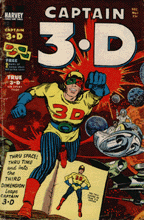
Captain 3-D is one of the most original creations in 3-D comic books and it features dynamic art by Jack Kirby. This Harvey comic book tells the story of Danny Davis, the young owner of a book store who is given a copy of The Book of D by a stranger. When Danny looks at the book using special 3-D glasses, Captain 3-D leaps suddenly from the page and out of the book.
Harvey Publications also produced three other 3-D comic books of the humorous type. George Baker's Sad Sack is featured in Harvey 3-D Hits. 3-D Dolly and Funny 3-D were designed for the younger reader. 3-D Dolly includes the first appearance of Richie Rich redrawn for 3-D.
National Comics produced two 3-D books in an oversize format to excellent effect. 3-D Superman is one of the most visually exciting of the 3-D comics. All the stories make use of full page opening splash panels, highly detailed. The first story, The Man Who Stole the Sun, pits Superman against his arch-enemy Lex Luthor with scenes of cosmic infernoes and tidal waves. The Origin of Superman is particularly dramatic in 3-D with panels depicting the planetary devastation of Krypton.
3-D Batman is a reprint of Batman No. 48 converted to stereo art with adventures including the Penguin and a Tommy Tomorrow story. National provided a unique pair of Batman's 3-D Glasses with the comic. 3-D Batman was reprinted in 1966 to capitalize on the success of the Batman television program. The inside covers of the 1966 3-D Batman contain photos of Adam West and Burt Ward who played the roles of Batman and Robin in the popular television series.
There were several giveaway 3-D comics and comic booklets in smaller formats. 3-D Cheerios giveaways feature Donald Duck and Mickey Mouse in a series of 24 different adventures. There were three different sets of eight comics. For 25 cents and a Cheerios boxlop you could send away for a complete set of eight comics.
The best of the 3-D comic books utilized art that was created especially for anaglyphic reproduction. A great many of the 3-D comics, however, used reprints converted to 3-D. Such was the case with the two Atlas (or pre-Marvel) 3-D comic books, 3-D Action and 3-D Tales of the West. The quality of the anaglyphic reproduction in the Atlas 3-D books is uneven and, while occasionally successful, varies from panel to panel.
Entertaining Comics also reprinted stories in 3-D to somewhat better effect. Three Dimensional EC Classics No. I contains art by Wally Wood, Bernie Krigstein, George Evans and Graham Ingels that is quite effective in 3-D. Wood's V-v-v Vampires story, in particular, makes use of lushly detailed panels with a strong impression of depth. Three Dimensional Tales From the Crypt of Terror No. 2 features four horror stories delineated by Jack Davis, Bill Elder, Johnny Craig and Joe Orlando.
John Benson's Squa Tront No. 5 contains an article on the EC 3-D process with art by Wood that gives examples of the manner in which images are stacked with acetate cels for anaglyphic reproduction. Most 3-D comics used three or four different levels. The EC 3-D comic books used as many as six levels. A third issue of Three Dimensional EC Comics was completed but never printed. One of the stories intended for this issue entitled The Planetoid is reproduced in its entirety in Black and White in Squa Tront No. 5. Highly detailed vistas of outer space are rendered by Al Williamson and George Evans. It is to be hoped that this third EC 3-D comic book will eventually be published in the format for which it was originally intended.
3-D Sheena, Jungle Queen, was one of three comic books that Fiction House Magazines produced in 3-D and the quality of the art depicting jungle beauties and jungle beasts is excellent. 3-D Circus features funny animal havoc. The most unusual Fiction House 3-D entry, however, is entitled The First Christmas and it was published in an oversize format. Each page of The First Christmas contains one large panel illustrating a scene from the birth of Christ in 3-D. The cover displays a Kelly Freas painting of the manger scene.
3-D-Ell comics were published by Dell Publishing. They deal with the antics of Rootie Kazootie and Flukey Luke. 3-D-EII comics are unique. They utilize photographs of three dimensional puppets with pasted up word balloons and sound effects rather than line art and the 3-D effect is quite vivid.
Steriographic Publications attempted to capture a female readership with 3-D Love and 3-D Romance. Introductory panels in 3-D Romance describe the 3-D process: Feel the greater intimacy of a kiss. The added warmth of a 3-D embrace! Girls could also enjoy 3-D in Katy Keene Three Dimensional Comics with Bill Woggon art. An oversize 3-D issue features Katy (The Pin-up Queen) in full page poses and clothing designs created by the readership.
Star Publications produced three technically uneven 3-D comic books in the realistic style. Their titles were Jungle Thrills, Western Fighters and Indian Warriors. Jungle Thrills contains adventures of Jungle Jo and Jungle Lil. In addition, Star produced one funny animal title, Pidgy and the Magic Glasses. The registration separating the red and green images in these books varies from page to page. These 3-D comic books do, however, feature excellent covers by L. B. Cole simulating the 3-D effect.
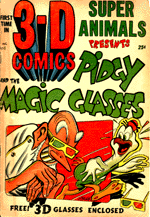
Picturescope Jungle Adventures from Star Publications as well is one of the most unusual comics produced as a result of the 3-D craze. It is a black and white story and coloring book with outstanding Jay Disbrow art producing A New Illusion Without Glasses. Each page contains one large panel simulating the effect of 3-D in much the same manner as the covers of many of the 3-D comics. Jahka, Lord of the Jungle, and his female companion Nianda are featured in Picturescope Jungle Adventures.
There were several other flat comic books which simulated the 3-D effect. If a panel is seen as a stereo window then the 3-D effect depicts an object or person passing through the window, protruding over the borders of the panel. The ads for the 3-D films and the covers of the 3-D comic books used this window effect to simulate 3-D.
The 3-D comics and their variants really only lasted less than a year. The 25-cent price may have contributed to low distribution and today the 1950's 3-D comics are difficult to find in fine or mint condition. The 1950's 3-D comic books are one of the unique art forms in American popular culture. They represent an effort to give maximum visual realism to the graphic story medium at a time when the social realism in the comics was under fire. Apart from their value as a novelty, they signify a traditional American regard for applied technology.
Comic books are the offspring of technology, a mass medium consisting of a complex chain of production and distribution. The 3-D comic books of the 1950's are a unique marriage of art and science in a popular medium.
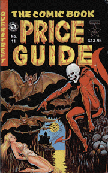
first published in the 1981 Overstreet Comic Book Price Guide (No. 11)
